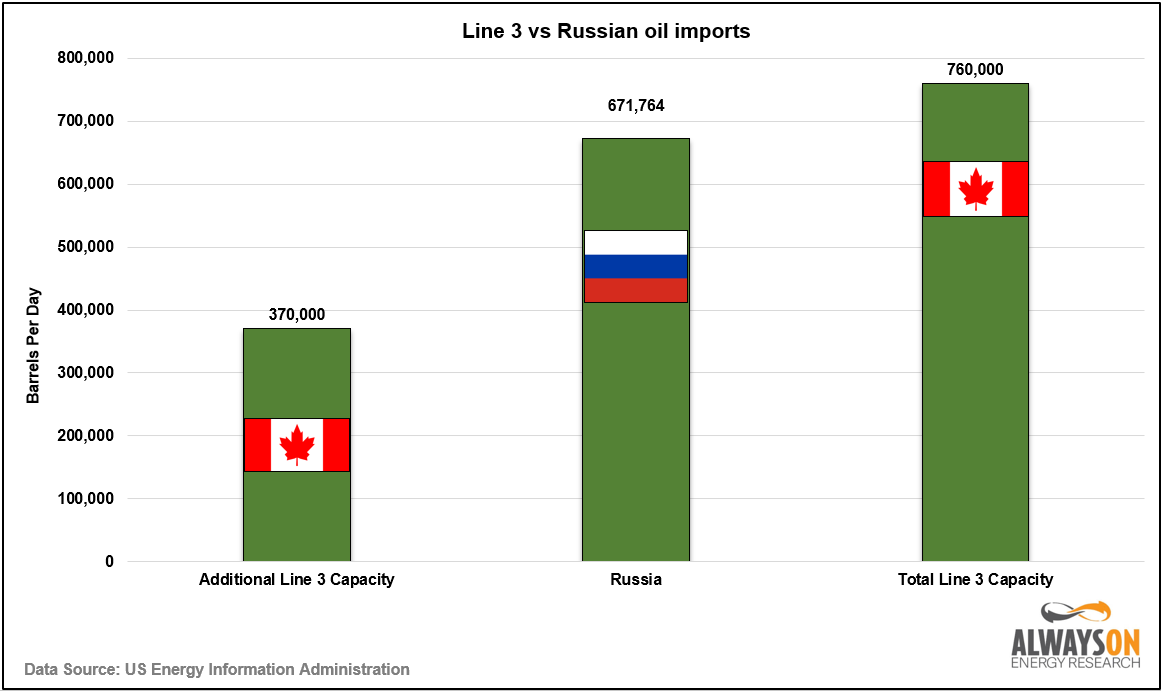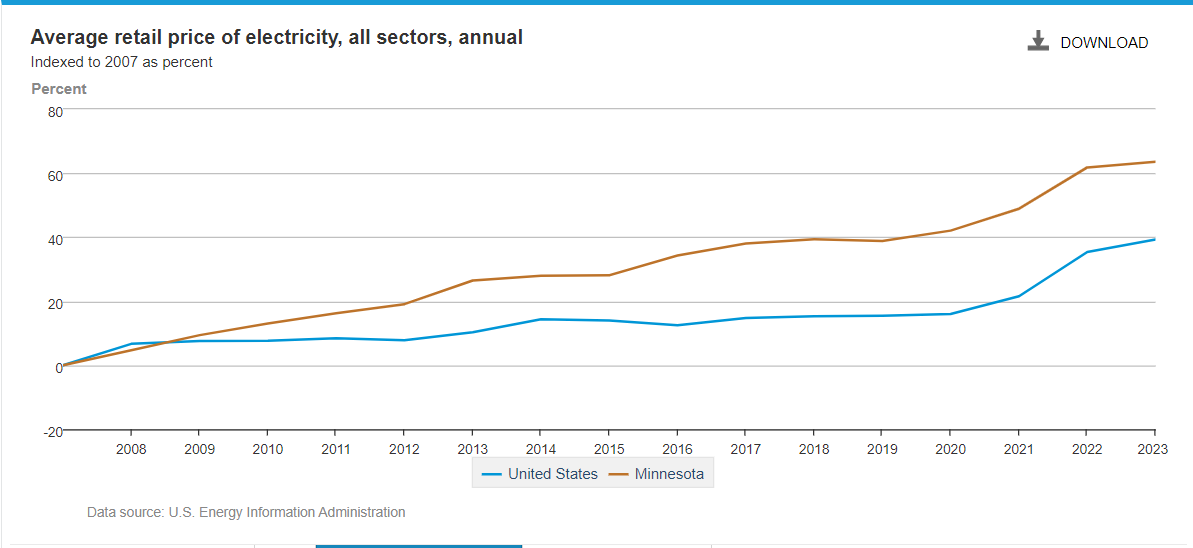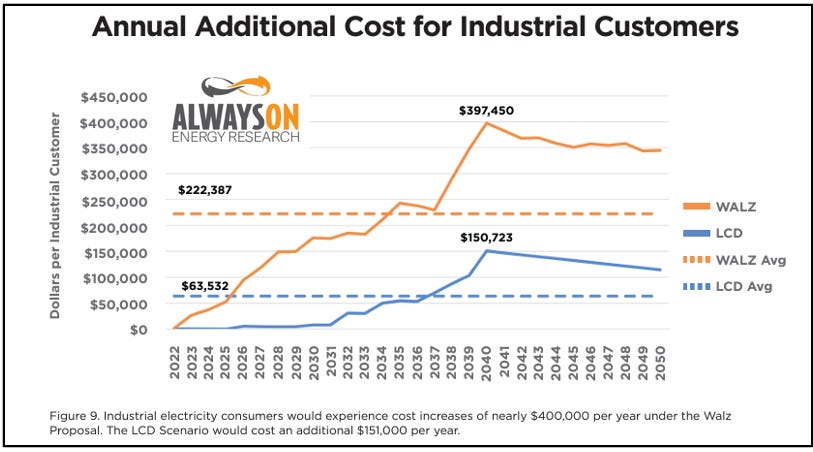We interrupt our regularly scheduled Saturday Substack post to bring you this important bulletin: On August 6, 2024th, Democratic Presidential nominee Kamala Harris selected Minnesota Governor Tim Walz as the Vice Presidential candidate.
No one has done more work analyzing Governor Walz's energy policies over the last six years than we have. Today, we detail the policies he has enacted or proposed in Minnesota and their implications for the nation.
In short, Walz has never seen a California energy policy he didn't try to implement in Minnesota. His standard tactic has been the bait-and-switch, first proposing a seemingly moderate policy during election season and then lurching to the extreme end of the spectrum at his first opportunity.
We are happy to be a source for your news stories or appear on podcasts.
Raising Gas Taxes
While campaigning for Governor in 2018, Walz said he was for a "modest" increase in the gas tax, but he did not mention a specific amount.
Once he was elected, he sought to raise the tax by 20 cents per gallon, a 70 percent increase. This massive tax hike would have cost the average Minnesota family an additional $207 per year and made Minnesota’s gas tax the 4th highest in the nation.
Nothing about this proposal was modest. Walz eventually caved due to public opposition to the massive proposed tax increase, but it was the start of a trend where the proposed policies of Governor Walz diverged from the rhetoric of candidate Walz.
Opposition to Oil Pipelines
On the campaign trail, Candidate Walz said he supported replacing the corroding Enbridge Line 3 oil pipeline, which was built in 1968 and was operating at half capacity due to safety concerns.
In late October 2018, Candidate Walz told the Minneapolis Star Tribune he was satisfied with the Public Utilities Commission’s (PUC) decision to allow the project to move forward. “The PUC did rule. We need to follow the process in place,” said Candidate Walz.
Upon being sworn into office, however, Governor Walz quickly changed his tune. Instead of allowing the project, which had received unanimous approval from the PUC, to move forward, the Governor’s office delayed it in February 2019.
In announcing his decision, Walz said, “When it comes to any project that impacts our environment and our economy, we must follow the process, the law, and the science.” However, the Governor also said projects like Line 3 “don’t only need a building permit to go forward, they also need a social permit.”
However, this so-called “social permit” clearly wasn’t considering the voice of the average Minnesotan. A 2021 poll by MinnPost found that a majority of Minnesotans (56 percent) supported replacing the pipeline, with the largest support coming from the rural counties (68 percent).
Walz ignored these voices and gave in to special interest groups.
In 2021, the Walz Administration’s Commerce Department and environmental activist groups like the Sierra Club opposed the Line 3 replacement project by arguing that we wouldn’t need the oil, even though the completed Line 3 pipeline would account for more oil imports than the U.S. was importing from Russia.
Not only do these statements look silly in the wake of Russia’s invasion of Ukraine, but delaying the replacement of a corroded oil pipeline that has been under review for four years based on subjective criteria of needing a “social permit,” in addition to a building permit, is the exact opposite of “following the science.”
In fact, “the science” clearly showed that delaying the replacement of this pipeline presented a more real and present danger to the environment than allowing for a newer, safer pipeline to be placed into service.
Data from the Pipeline and Hazardous Materials Safety Administration show that from 2010 to 2023, corrosion was the leading cause of pipeline-related oil spills.
Governor Walz’s decision to move the goalposts on a project that has completed an exhaustive environmental review is not the kind of common-sense or fair compromise Walz sought to portray on the campaign trail.
Wind and Solar Mandates and Blackouts
When running for Governor in 2018, Walz campaigned on passing new wind and solar mandates requiring 50 percent of Minnesota's electricity to come from these resources by 2030. Then, in early 2019, he lurched again to a 100 percent carbon-free mandate by 2050.
Then, in 2021, Walz decided to knock ten years off the target date for the proposed mandates, moving it up to 2040. This quadrupled down on the bad energy policy requiring 25 percent of the state's power to come from renewables by 2025, which has caused Minnesota's electricity prices to soar.
Residential Electricity Prices
Since the first wind and solar mandate was enacted in 2007, Minnesota's electricity prices have increased 1.67 times faster than the national average. Insanity is doing the same thing over and over and expecting different results. In this case, Walz wanted to do it four times more.
In 2023, Governor Walz signed the 100 percent carbon-free electricity mandate into law. Our research found this will cause painful electricity price increases for Minnesota families and businesses and cause massive blackouts.
Our analysis found Walz's wind and solar mandates would cost $313 billion through 2050, causing electricity bills for families to increase by an average of $1,642 per year, or $136 per month, reaching an additional $2,934 by 2040.
Industrial Electricity Prices
Manufacturing is a key part of the economy in Midwestern states like Minnesota, Wisconsin, Michigan, and Ohio, but Walz's wind and solar mandates would cost these firms an average of $222,387 per year, every year through 2050.
Minnesota's industrial electricity prices are already so high that the Northern Foundry in Hibbing, Minnesota, the home of Bob Dylan, closed its doors explicitly citing power costs. Walz's energy policies killed 91 high-paying union jobs.
As we wrote in Green Deindustrialization Comes to America, from 2009 to 2023, Minnesota Power, the Investor-Owned Utility that served Northern Foundry, has increased electricity prices for industrial customers like the foundry by 62 percent, compared to the US average increase of only 18 percent, making it increasingly difficult for energy-intensive businesses to compete with firms in other states and countries with more rational energy policies.
Northern Foundry was the definition of an energy-intensive business. The firm used electric induction furnaces to melt ductile iron into parts used for the automotive, heavy truck, industrial, and recreational industries. When operating at full capacity, the facility consumed six megawatts (MW) of power, equivalent to the average consumption of 5,660 Minnesota homes.
In an average year, this facility would likely use more than 30,000 megawatt-hours (MWh) of electricity, and as electricity rates have risen, Northern Foundry’s costs increased by an estimated $1.2 million, or about 27 percent of the company’s payroll. Ultimately, they saw the writing on the wall and closed up shop for good.
As a result, 91 people lost their jobs. The average annual pay for employees was around $48,900, with opportunities for overtime, healthcare benefits including dental and vision, 401k contributions, and even a match for 529 college savings plans, so workers could save money and invest it to pay for their children’s educations.
While $48,900 may not seem like much for people living in urban areas, it is a very good wage in Hibbing. The U.S. Census Bureau estimates the median household income in Hibbing is $52,881, meaning one person working at Northern Foundry was almost making as much as the average household in the area.
Blackouts
Our analysis of Minnesota’s 100 percent carbon-free mandate also found that a Minnesota grid powered by wind, solar, and battery storage would experience a 55-hour blackout in winter because the wind stopped blowing.
This is why we called the carbon-free mandate the "Blackout Bill."
In a display of legislative hubris, Walz and the Democrats in the legislature refused to put in place any sensible offramps into the Blackout Bill for cost or reliability. Democrats explicitly voted NO on suspending the mandates if there was a blackout and also voted no on proposed cost containment measures.
During the legislative process, Walz and the Democrats also voted down amendments offered by Republicans to legalize the construction of new nuclear power plants in Minnesota. Our modeling found building new nuclear power plants would have allowed them to meet their carbon-free goals for far less money and prevented blackouts.
This is Green New Deal-type stuff.
Electric Vehicle Mandates
Walz is also a fan of imposing California's energy policy on Midwesterners without legislative approval.
In 2019, he instructed his Minnesota Pollution Control Agency (MPCA) to enact California’s Zero-Emissions (ZEV) mandates, forcing auto dealers to stock 14,000 electric vehicles on their lots in the first year of the program without the legislature's approval.
The problem is that EVs don't work very well in Minnesota because the batteries are drained by up to 40 percent if people use the heater in the car. That relegates them to a luxury purchase for affluent people, and as
notes in this piece, over the past decade, about half of all the EVs sold in the U.S. were sold in the most heavily Democratic counties in the country.In this case, the process is more worrisome than the policy. Walz rammed through the EV mandates by exploiting a provision in existing law that James Dickey of the Upper Midwest Law Center (UMLC) argued did not grant the agency the power to regulate statewide greenhouse gas emissions from automobiles.
However, like the Obama administration, which used Section 111 rules to regulate greenhouse gases from the power sector, the Governor is willing to use the administrative state to enact policies that would not be passed by the legislature.
Low Carbon Fuel Standard
In 2022, Gov. Tim Walz proposed the adoption of California’s “Low Carbon Fuel Standard” (LCFS), a policy designed to further raise prices at the pump and act as another tax on Minnesota residents.
Despite claims from LCFS advocates that there is “no correlation between the policy and gas prices,” a new report from California admits this policy will drive up gasoline costs by 47 cents per gallon in 2025 and 52 cents per gallon in 2026. In Oregon, there is an entire webpage called “Annual Cost of the Clean Fuels Program,” admitting that these policies do indeed increase costs for consumers.
The LCFS proposed by the Minnesota legislature was the most aggressive in the nation, requiring a 25 percent reduction in the carbon intensity of fuels below a 2018 baseline by the end of 2030, a 75 percent reduction by the end of 2040, and a 100 percent reduction by the end of 2050.
Our report found this legislation would increase gasoline prices by 39 to 45 cents per gallon by 2030 and cost Minnesota families an average of $350 to $476 more for gasoline expenses.
However, our research also found that the LCFS would disproportionately harm rural Minnesota families because they have further to drive to get to work, the doctor’s office, or the grocery store.
For example, families in Grant, Jackson, and Wilkin counties would pay the most, paying an additional $962, $1,150, and $1,151 in 2030, respectively, because of these regulations. The map below shows the average household cost based on the average vehicle miles traveled in each county.
Implications for America
The selection of Tim Walz as the Vice Presidential candidate has been touted as a way for the Harris campaign to appeal to rural Midwestern voters, but his track record on energy is more aligned with voters in San Francisco than St. Cloud.
Walz’s track record suggests that a Harris Administration would be a continuation of the Biden Administration’s energy policies, where pipelines are obstructed or canceled, unreliable wind and solar facilities and electric vehicles are propped up with federal tax dollars, and the administrative state is weaponized to punish coal and natural gas generators with an endless onslaught of onerous Environmental Protection Agency (EPA) regulations.
These policies will be especially harmful for rural America, where having reliable transportation and energy are especially critical, and where energy-intensive industries like farming, mining, and manufacturing are often the economic lifeblood of their communities.
Based on the track record of the candidates, a Harris-Walz administration will be a continuation of the current Administration’s policies at best and a Green New Deal at worst.
There won’t be a post this weekend. See you next Saturday.
















Thank you. This is good to know. The Democrats, to the credit of their political skills, manage to persuade voters to murder babies and avoid the real issues that can improve the quality of life for ALL. I wish Trump and Vance would stick to the true issues and stay away from the Social issues
Even after quitting alcohol four years ago, I am much more sobered by your narrative about Gov. Walz, Bad Boys. It looks like you two will have to be the historians and critics of political energy in the US for next 90 days. Thanks in advance, Steve.